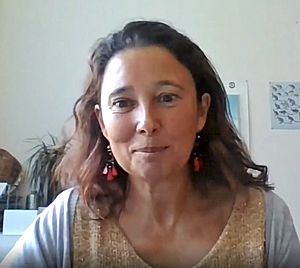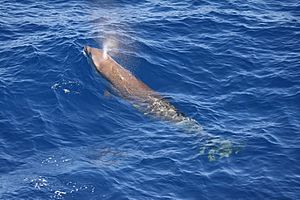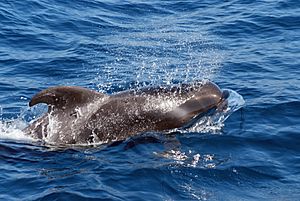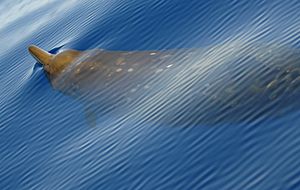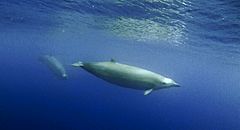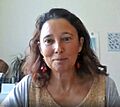Natacha Aguilar de Soto facts for kids
Natacha Aguilar de Soto is a Spanish marine biologist. She works at the University of La Laguna (ULL) in Tenerife, Canary Islands. She is a special research and teaching expert there. She also worked as a research fellow at ULL and at the University of St. Andrews in Scotland.
Natacha Aguilar de Soto leads research on cetaceans, which are marine mammals like whales and dolphins. She studies how deep-sea whales, such as beaked whales and pilot whales, dive and behave. Her work helps scientists understand how these animals find food.
She also studies bioacoustics, which is the study of sounds made by animals. She looks at how ocean noise affects whales and dolphins. Her research helps create rules to protect these animals from human noise. Natacha is also a co-founder of two important groups: Asociación GIC and CETAVIST.
Contents
Natacha's Journey in Science
Natacha Aguilar de Soto earned her doctorate in Biology from the University of La Laguna (ULL) in the Canary Islands. She started studying at ULL and began watching Blainville's and Cuvier's beaked whales in 2002. She finished her Ph.D. work in 2006.
As part of the BIOECOMAC research group at ULL, she directs studies on whales and their sounds. She managed projects like SOUNDMAR (2010–2013) and ECOSOUND (2015–2017). These projects received funding from the European Union. In 2017, she became a Ramón y Cajal fellow at ULL. This is a special position for top researchers.
Protecting Whales in the Canary Islands
Natacha is the president and co-founder of Asociación GIC. This group started in 2003 to study and protect marine mammals in the Canary Islands.
She also helped start CETAVIST in 2012. This is a network where everyday people, called citizen scientists, help spot whales and seabirds. Volunteers travel on passenger ferries and record what they see. Between 2012 and 2016, they completed over 1,300 surveys. This information helps scientists understand where whales and seabirds live.
Natacha Aguilar de Soto has also worked with international groups. These groups look at how ocean noise affects marine life. She has helped with efforts to reduce noise pollution in places like the Canary Islands, New Zealand, and Australia. In 2019, she was named a "Hope Spot Champion." This was part of a campaign to protect the marine area around Tenerife-La Gomera.
Discoveries About Whales
Natacha Aguilar de Soto's research covers many topics. She studies how deep-diving whales feed and communicate. She also looks at where whales and seabirds live. A big part of her work focuses on how humans affect the ocean. This includes noise pollution and whales crashing into boats.
The Canary Islands are home to at least 26 types of whales and dolphins. This includes several kinds of beaked whales. At least five species live there all year round. This is the only place in the North Atlantic where this happens.
Between 1985 and 2003, many beaked whales got stranded on beaches. This happened when naval exercises were taking place nearby. Because of this, in 2004, Spain stopped using naval sonar within 92 kilometers (57 miles) of the Canary Islands. This was a big step to protect the whales.
In 2003, Natacha started a long-term study of Blainville's and Cuvier's beaked whales. She used special tags called DTAGs. These tags stick to the whales with suction cups and eventually fall off. They record sounds and movements, sending data back to researchers. This helped her understand how these whales behave and live in groups.
Natacha's Ph.D. research focused on the sounds and diving of short-finned pilot whales and Blainville's beaked whales. She found that pilot whales make fast, deep dives to catch prey. Then they come back to the surface to breathe and rest. This showed scientists that marine animals use a lot of energy when hunting in the deep ocean. Her research changed how scientists think about whale diving and feeding. It also helps guide rules for whale watching and shipping.
Natacha also helped study the effects of a submarine volcanic eruption near El Hierro Island in 2011-2012.
In 2012, Natacha co-wrote an article about how Blainville's beaked whales hide from killer whales. They stay completely silent when they swim up to the surface or when they are less than 170 meters (558 feet) deep. They only make sounds for echolocation (finding things with sound) and talking when they are deeper. This helps them avoid being found by predators.
Natacha and other scientists studied sperm whales in the Canary Islands. They estimated that about 224 sperm whales live there. They also looked at how many sperm whales were getting stranded due to crashing into ships. Data showed that the Canary Islands is one of the places with the most whale strandings from ship collisions. This problem might be causing the sperm whale population to shrink.
Because of this study, new steps were suggested to help. For example, ship captains training at the ULL Nautical Engineering School now learn about this issue.
In 2017, Natacha co-authored a study that included the first-ever underwater video of living True's beaked whales. These are very rare whales that are hardly ever seen. The video was taken by students off the coast of the Azores. The students didn't even know how special their video was until Natacha confirmed the species later!
Awards and Honors
- 2018, Award for outstanding female researchers, University of La Laguna
Images for kids
See also
 In Spanish: Natacha Aguilar de Soto para niños
In Spanish: Natacha Aguilar de Soto para niños


